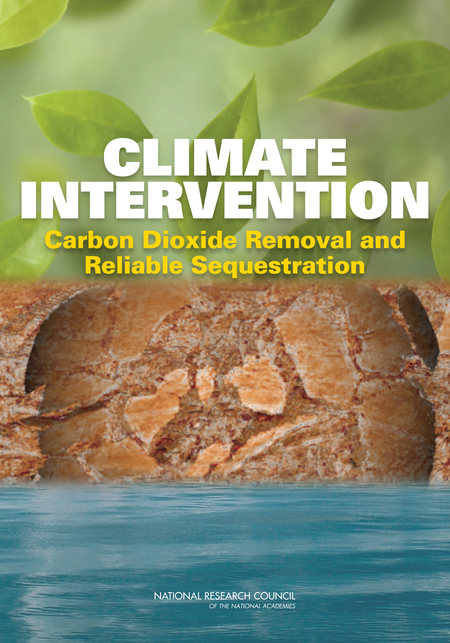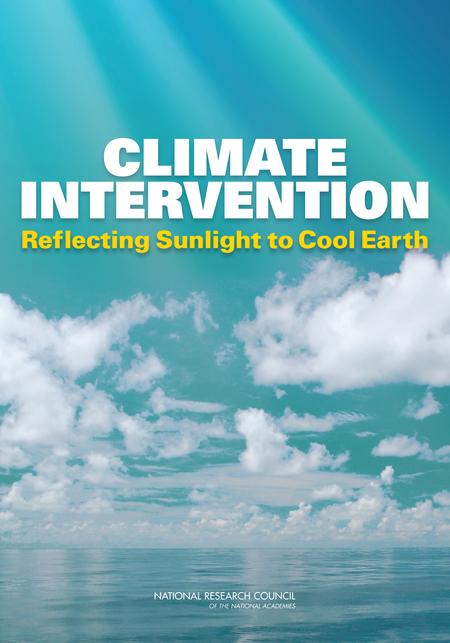
This article is a lightly edited version of a news release posted by the National Academy of Sciences (NAS) on Feb 10, 2015.
There is no substitute for dramatic reductions in greenhouse gas emissions to mitigate the negative consequences of climate change, a National Research Council committee concluded in a two-volume evaluation of proposed climate-intervention techniques. The two reports are:
Strategies to remove carbon dioxide from the atmosphere are limited by cost and technological immaturity, but they could contribute to a broader portfolio of climate change responses with further research and development. Albedo-modification technologies, which aim to increase the ability of Earth or clouds to reflect incoming sunlight, pose considerable risks and should not be deployed at this time.

Carbon dioxide removal and albedo-modification techniques have been grouped up until now under the common term “geoengineering,” but they vary widely with respect to environmental risks, socio-economic impacts, cost, and research needs. Carbon dioxide removal addresses the root cause of climate change — high concentrations of the greenhouse gas in the atmosphere — and generally have well-understood benefits and risks, but current technologies would take decades to achieve moderate results and be cost-prohibitive at scales large enough to have a sizeable impact. By contrast, albedo-modification techniques would only temporarily mask the warming effect caused by high CO2 concentrations, and present serious known and possible unknown environmental, social, and political risks, including the possibility of being deployed unilaterally.
These differences led the committee to evaluate the two types of approaches separately in companion reports, a distinction it hopes carries over to future scientific and policy discussions. In addition, the committee believes that these approaches are more accurately described as “climate intervention” strategies — purposeful actions intended to curb the negative impacts of climate change — rather than engineering strategies that imply precise control over the climate.
“That scientists are even considering technological interventions should be a wake-up call that we need to do more now to reduce emissions, which is the most effective, least risky way to combat climate change,” said committee chair Marcia McNutt, editor-in-chief of Science and former director of the U.S. Geological Survey.“But the longer we wait, the more likely it will become that we will need to deploy some forms of carbon dioxide removal to avoid the worst impacts of climate change.”

If society ultimately decides to intervene in Earth’s climate, any actions should be informed by a far more substantive body of scientific research, including ethical and social dimensions, than is presently available, the committee said. Decisions regarding deployment of carbon dioxide removal technologies will be largely based on cost and scalability, and research is needed to make current options more effective, more environmentally friendly, and less costly. Conversely, any future decision about albedo modification will be judged primarily on questions of risk, and there are many opportunities to conduct research that furthers basic understanding of the climate system and its human dimensions — without imposing the risks of large-scale deployment — that would better inform societal considerations.
“If the world cannot slow emissions or the effects of climate change are more extreme or occur sooner than expected, there may be demands to pursue additional climate-intervention technologies about which scientists need a better understanding,” said National Academy of Sciences President Ralph J. Cicerone.“Although riskier ideas to lessen the amount of energy absorbed from the sun should not be considered for deployment, they should be studied so that we can provide answers if someday these ideas begin to be considered in attempts to avert catastrophe. These reports should guide federal agencies in supporting research on climate-intervention technologies, while keeping separate any decision-making about their implementation.”
Carbon dioxide removal and sequestration
Some carbon dioxide removal strategies seek to enhance or mimic the natural processes that already remove about half of the world’s carbon emissions from the atmosphere each year. Environmental risks vary among the proposed technologies (listed below), but overall the risks are relatively low and generally understood. However, most carbon dioxide removal strategies have limited technical capacity, and absent some unforeseen technological innovation, large-scale deployment would cost as much or more than replacing fossil fuels with low carbon-emission energy sources, the committee said.
The committee recommended federal research and development investment to improve methods of carbon dioxide removal and disposal at scales that would have a significant global climate impact. In particular, research is needed to minimize energy and materials consumption, identify and quantify risks, lower costs, and develop reliable sequestration and monitoring capabilities.
Technologies that prevent sunlight from reaching Earth’s surface could reduce average global temperatures within a few years, similar to the effects of large volcanic eruptions. While many albedo-modification techniques have been proposed, the committee said two strategies that could potentially have a significant impact are injection of aerosols into the stratosphere and marine cloud brightening. Unlike carbon dioxide removal, these methods would not require major technological innovation to be implemented and are relatively inexpensive compared with the costs of transitioning to a carbon-free economy.
However, albedo modification would only temporarily mask the warming effect of greenhouse gases and would not address atmospheric concentrations of CO2 or related impacts such as ocean acidification. In the absence of CO2 reductions, albedo-modification activities would need to be sustained indefinitely and at increasingly large scales to offset warming, with severe negative consequences if they were to be terminated. In addition, albedo modification introduces secondary effects on the ozone layer, precipitation patterns, terrestrial and marine ecosystems, and human health, with unknown social, political, and economic outcomes.
Many of the processes most relevant to albedo modification — such as those that control the formation of clouds and aerosols — are among the most difficult components of the climate system to model and monitor. Present-day observational capabilities lack sufficient capacity to monitor the environmental effects of an albedo-modification deployment. Improvements in the capacity to monitor direct and indirect changes on weather, climate, or larger Earth systems and to detect unilateral or uncoordinated deployment could help further understanding of albedo modification and climate science generally.
The committee said it would be “irrational and irresponsible” to implement sustained albedo modification without also purse emissions mitigation, carbon dioxide removal, or both. It opposed deployment of albedo-modification techniques, but recommended further research, particularly “multiple-benefit” research that simultaneously advances basic understanding of the climate system and quantifies the technologies’ potential costs, intended and unintended consequences, and risks.
Albedo-modification research will have legal, ethical, social, political, and economic ramifications. The committee recommended the initiation of a serious deliberative process to examine what international research governance structures may be needed beyond those that already exist, and what types of research would require such governance. The degree and nature of governance should vary by activity and the associated risks, and should involve civil society in decision-making through a transparent and open process.
The study was sponsored by the National Academy of Sciences, U.S. intelligence community, National Aeronautics and Space Administration, National Oceanic and Atmospheric Administration, and U.S. Department of Energy. The National Academy of Sciences, National Academy of Engineering, Institute of Medicine, and National Research Council are private, independent nonprofit institutions that provide science, technology, and health policy advice under a congressional charter granted to NAS in 1863. The National Research Council is the principal operating arm of the National Academy of Sciences and the National Academy of Engineering. For more information, vsit http://national-academies.org.
Posted by John Hartz on Sunday, 15 February, 2015
 |
The Skeptical Science website by Skeptical Science is licensed under a Creative Commons Attribution 3.0 Unported License. |